Royal touch facts for kids
The royal touch was a special way that French and English kings and queens tried to heal people. They would touch their subjects, no matter if they were rich or poor, hoping to cure them of different sicknesses. This special healing power was most often used for a disease called scrofula, also known as the "King's Evil." From the 16th century onwards, it was used almost only for scrofula. This disease rarely caused death and often got better on its own, which made it seem like the monarch's touch had cured it. Kings and queens who wanted to show they had a true claim to the throne often used this claimed power.
Contents
How the Royal Touch Started
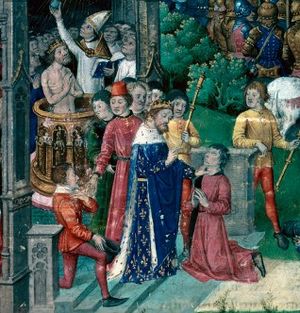
Only the kings and queens of England and the kings of France claimed to have this special gift from God to heal by touching sick people. They believed this showed that God thought highly of their royal families. However, they never agreed on which of their ancestors first received this power.
In England, people said that Edward the Confessor (who ruled from 1042 to 1066) was the first king to have the royal touch. The French, however, usually said their kings' healing gift started with Philip I (who ruled from 1059 to 1108) or even Robert II (who ruled from 987 to 1031). They disagreed that Saint Edward used the royal touch. They insisted that the first English king to claim this ability was Henry I (who ruled from 1100 to 1135). They thought his touching was just a political copy of the gift given only to French kings.
A doctor named André du Laurens (1558–1609) said that Clovis I (who ruled from 481 to 511) was the first king to touch for scrofula. But a historian named Marc Bloch (1886–1944) thought it was probably Philip I. Today, many experts, especially Frank Barlow (1911–2009), believe the French practice most likely started with Saint Louis IX (who ruled from 1226 to 1270).
The earliest clear proof of the royal touch in England comes from money records during the time of Edward I (who ruled from 1272 to 1307). Edward I was away on crusades and didn't arrive in England until 1274. But by 1276, it was common to give one penny to each patient. This suggests the practice had been around since at least the time of his father, Henry III (who ruled from 1216 to 1272). Henry III was known for making his own choices and loved public events. He was also very religious, like his brother-in-law, Saint Louis IX. All of this makes it likely that he brought the practice to England.
The Royal Touch in England
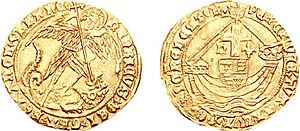
The kings after Henry I didn't think the royal touch was super important, so they didn't use it as much. It remained a small part of being king until the 1600s. Then, it suddenly became very popular and was written about a lot.
Since the time of Edward IV (who ruled from 1461–1470 and 1471–1483), kings gave the sick person a gold coin called an Angel. They would hang it around the person's neck. One side of the coin showed a ship, and the other side showed the archangel Michael fighting a dragon. This is why it was called an Angel. These Angels were money, worth about 6 shillings and 8 pence when they were first used. But when they were given as a Touch piece, they had a hole so they could be worn. People were told to wear the coin all the time for the healing to work. Not everyone believed in the royal touch; many just wanted the valuable gold coin. When Angel coins stopped being made in 1634, a small gold medal was made instead for the royal touching.
How the Ceremony Worked
Henry VII (who ruled from 1485–1509) was the first king from the Tudor family. He was very focused on proving his right to rule. He was the one who firmly set up the rules for the royal touch ceremony, using what his earlier kings had done. It had four main parts:
- The king or queen touched (or stroked) the sick person's face or neck.
- The king or queen hung the special coin around the person's neck.
- Parts of the Gospel of Mark (16: 14–20) and the Gospel of John (1: 1–14) were read from the Bible. Mark 16 talks about how the king or queen would be safe from sickness: "They shall take up serpents; and if they drink any deadly thing, it shall not hurt them; they shall lay hands on the sick, and they shall recover." Mark 16:18
- Prayers were said. Before the English Reformation, prayers were said to God, but also to Virgin Mary and other saints.
| "A most miraculous work in this good king; Which often, since my here-remain in England, I have seen him do. How he solicits heaven, Himself best knows: but strangely-visited people, All swoln and ulcerous, pitiful to the eye The mere despair of surgery, he cures, Hanging a golden stamp about their necks, Put on with holy prayers: and 'tis spoken To the succeeding royalty he leaves The healing benediction" |
| Malcolm describing Edward the Confessor's touch, in William Shakespeare's Macbeth, Act IV, Scene 3 |
The touch was first meant to cure scrofula (King's Evil), rheumatism, convulsions, fevers, blindness, goitre, and other problems. However, since the time of Elizabeth I (who ruled from 1558–1603), the touch was only used for people with scrofula. The way Henry VII did the ceremony rarely changed. Elizabeth I would make the Sign of the Cross over the sick person's head. Her successor, James I (who ruled from 1603–1625), who was a bit squeamish, would just make stroking motions over the swollen areas instead of actually touching them.
How Often It Happened
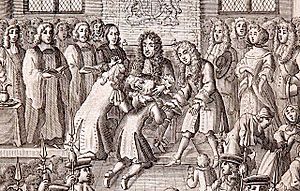
The ceremony usually happened between September 29 (Michaelmas) and Easter. During these colder months, it was less likely to catch a disease from a sick person. People also believed the healing would work better if done on a holy day. English kings and queens generally touched people less often than French kings. Edward I touched up to 1,736 people each year, but he didn't touch anyone during his many military trips abroad. The kings after him did similar things.
Henry VII touched seven or eight sick people each year, and sometimes he didn't do the ritual for several years. Henry VIII (who ruled from 1509–1547) touched 59 people between early January 1530 and late December 1532. The Protestant king Edward VI (who ruled from 1547–1553) apparently didn't perform the ritual. But the Catholic queen Mary I (who ruled from 1553–1558) took it more seriously.
Early in her reign, the Protestant Elizabeth I was not keen on doing the ritual because she probably doubted if it worked. But she started doing it again in 1570 after the Catholic Church kicked her out and said she had lost her healing touch. Elizabeth, however, made it clear that her own role in the healing was not the most important part. Her surgeon, William Clowes, said that the royal touch proved she was the rightful queen. He even claimed Elizabeth could heal foreigners, giving a Dutchman as an example.
Even though James I was a very strong Protestant and wanted to stop the practice, he had to touch more and more people. The practice spread to Scotland, where James was also king before England and Scotland joined under one crown. The Scots started believing their king, now also king of England, could heal them. Charles I (who ruled from 1625–1649) issued many orders to try and control the growing public demand. On December 27, 1633, he touched 100 people at Holyrood Palace.
| "To that soft charm, that spell, that magick bough, That high enchantment I betake me now: And to that hand, the branch of Heavens faire tree, I kneele for help; O ! lay that hand on me, Adored Cesar! and my faith is such, I shall be heal'd, if that my King but touch. The evill is not yours: my sorrow sings, Mine is the evill, but the cure, the Kings. " |
| Robert Herrick's To the King, to cure the Evill (Hesperides, 1648) |
The royal touch was used most often during the reign of Charles II (who ruled from 1660–1685). He was the only English king who used the royal touch more than French kings. He touched over 92,000 people with scrofula – more than 4,500 each year. James II (who ruled from 1685–1688) was very doubtful about the ritual but still did it. He was removed from power by William III (who ruled from 1689–1702) and Mary II (who ruled from 1689–1694). They refused to take part in what they thought was just an old belief. When someone asked William for a touch, he supposedly said: "God grant you better health and better sense."
Queen Anne (who ruled from 1702–1714) brought the practice back almost as soon as she became queen. She touched 30 people on October 6 and 20 people on December 19, 1702. She took it very seriously, even fasting the day before to prepare herself spiritually. The famous writer Samuel Johnson was a baby when Queen Anne touched him. On April 27, 1714, three months before she died, she performed the ritual for the last time. George I (who ruled from 1714–1727) stopped the practice for good. However, the Jacobite heirs of the exiled James II still claimed they could heal by touch until the 1780s.
A doctor named Sir Richard Blackmore praised William III and George I for stopping "that superstitious and insignificant ceremony." He believed it was a "Popish" (Catholic) trick. The Glorious Revolution and the later end of the idea of the divine right of kings (that kings get their power directly from God) made the royal touch unnecessary to prove a monarch's right to rule. Reports of Jacobite claimants curing scrofula by touch were rejected by a writer in the General Evening Post. They wrote: "The illustrious Royal Family now on the Throne despise such childish Delusions, such little pious Frauds, to prove their Divine Right to the Crown. They act upon noble Principles; they want no trickery to support their Throne." The ceremony was finally removed from the official prayer book in 1732.
The Royal Touch in France
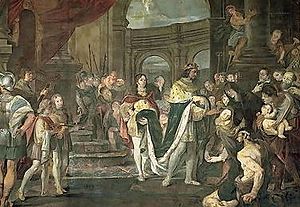
By the Late Middle Ages, the royal touch had become a very important part of the coronation ceremony at Reims Cathedral. The ceremony included blessing the king's hands with holy oil, which people believed gave him the power to heal. Right after the coronation, the new king would travel to Corbeny. This was where the shrine of Saint Marcouf (who died in 558), the patron saint of people with scrofula, was located. After this pilgrimage, the newly crowned king was believed to have the sacred power of touch.
On his deathbed, Philip IV (who ruled from 1285–1314) reportedly told his son and heir, Louis X (who ruled from 1314–1316), about healing scrofula by touch. Philip VI (who ruled from 1328–1350), the first king from the Valois family, wanted to show that he had the same healing powers as his royal relatives and ancestors. This would prove he was their rightful heir. He touched 35 people between January 1 and June 30, 1337. Some of them had traveled from places like Brittany and Brabant.
A demonologist named Pierre de Lancre (1553–1631) proudly said that even dead French kings could heal. In the 1500s, people still believed that Saint Louis IX's arm, kept in a monastery in Spain, still had healing power. To be touched by the French king, people traveled from as far away as present-day Italy and Spain even in the 1200s. Foreigners were ranked in a specific order, with the Spanish getting to go before everyone else, and the king's own subjects coming last.
During the Wars of Religion
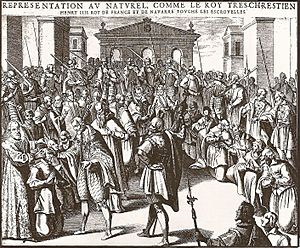
The idea of the royal touch helped make the monarchy seem more powerful. However, the ceremony was not performed very often in the 1500s. During the French Wars of Religion (1562–1598), conditions worsened, and scrofula spread more than ever. People became more interested in the disease.
The Catholic League started spreading information claiming that Henry III (who ruled from 1574–1589) could not heal by touch because of his bad behavior. After Henry III was killed and the Protestant Henry IV (who ruled from 1589–1610) became king, the League warned that God would take away his gift if the French accepted a Protestant as their ruler. They said people with scrofula would never be cured again.
After Henry IV changed to Catholicism and gained control, he was seen not only as the healer of scrofula but also as the healer of the kingdom. As the first king from the Bourbon family on the French throne, he decided to use this ability to confirm his right to rule. However, he had a problem: he was crowned at Chartres Cathedral instead of Reims. This meant he didn't visit the shrine of Saint Marcouf. He said that the royal touch was something he inherited from his ancestors and received by God's grace, not something given by the coronation ceremony. Henry decided not to show his "divine gift" right after his coronation in February 1594. Instead, he saved this special part of his kingship for his entry into Paris in March. Two weeks later, on Easter, Henry used his healing power for the first time. He was determined not to show any doubt about the ritual, fearing it might make people question if he truly changed his religion.
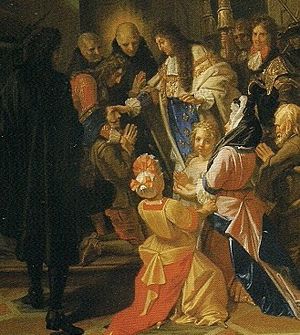
Henry IV's choice to continue the practice showed his subjects that God approved of his reign. Royal doctors and others who saw these ceremonies said that at least half of all the sick people he touched were healed within days. The ceremonies took place in other cities and at least four times a year: on Easter, on Pentecost, on All Saints Day, and on Christmas. On Easter 1608, Henry IV touched 1,250 people with scrofula. He complained that the hours-long ceremony made him tired, but he kept doing it. He always made it seem like he was doing it only because he cared about his subjects' well-being. The ceremony was performed with royal princes, officials who gave charity, bodyguards, and doctors present. The doctors would present patients to Henry, and he would make the sign of the cross on the sick person's cheeks, touch their sores, and say: "The King touches you, God cures you." (French: "Le Roy te touche et Dieu te guérit.")
When the Practice Ended
Louis XIII (who ruled from 1610–1643) and Louis XIV (who ruled from 1643–1715) both actively took part in touching ceremonies. Louis XIV touched 1,600 people on Easter 1680. Voltaire (1694–1778), a famous writer, mockingly wrote that he stopped believing in the royal touch when he heard that one of Louis XIV's mistresses died of scrofula "despite being very well touched by the king."
After 1722, the sentence the king said when touching the sick changed to a more hopeful one: "The King touches you, may God heal you." (French: "Le roi te touche, Dieu te guérisse.") This new phrase suggested that God might or might not grant the king's wish, rather than definitely curing the person. Louis XV (who ruled from 1715–1774) was doubtful about the royal touch. He performed it early in his reign, but he caused a scandal when he didn't call for people with scrofula at Easter in 1739. He never touched the sick again after that. The custom was stopped for 36 years until Louis XVI (who ruled from 1774–1792) brought it back at his coronation on June 11, 1775. He touched 2,400 people then. That was probably the only time he touched people with scrofula.
After the Bourbon family returned to power in France, Louis XVIII (who ruled from 1814–24) is not recorded to have used the custom. However, his successor Charles X (who ruled from 1824–30) touched 121 of his subjects at his coronation on May 29, 1825. He did this to show a connection with the old system of government (Ancien Régime) and its claim of divine right. The royal touch was never used again in France.
What We Learned and Other Healing Powers
The royal touch wasn't the only "miraculous" healing power that European rulers were believed to have. Medieval kings of Castile were said to be able to drive out evil spirits by making the sign of the cross and calling on God. Their Hungarian counterparts supposedly cured jaundice (a sickness that makes skin yellow). Similarly, English monarchs gave out cramp-rings, which were said to cure "evil" sicknesses like cramps and epilepsy.
Inoculation, an early form of immunization (getting protection against disease), was brought to England during the time of George I, who had completely stopped the royal touch in his kingdom. The royal family strongly supported it, but people disagreed about it for medical, political, and religious reasons. The history expert Adrian Wilson said it was "the Whig and Hanoverian equivalent of the Stuart practice of touching for scrofula." He added, "But while the Royal Touch used God's power, based on family right, inoculation used natural powers controlled by humans, with the monarch as a kind helper rather than a necessary part."
Historians have had different ideas about the royal touch. In the 1800s and early 1900s, they often disapproved of it. But more recently, they have looked at it with more understanding. The politician Lord Macaulay (1800–1859) made fun of it as a "silly old belief from a time before modern science and ideas." The historian Marc Bloch (1886–1944) was puzzled by how long the practice lasted. He agreed with Lord Macaulay that it was based on a kind of mass hysteria (a large group of people getting excited or worried together). However, more recently, historians have avoided saying that the royal touch was popular just because people were easily fooled.
In Stories
In The Return of the King, Aragorn proves he is the rightful king of Gondor by showing he has the "hands of a healer." He saves as many people as he can after the big battle.
See also
- Faith healing
- History of tuberculosis

